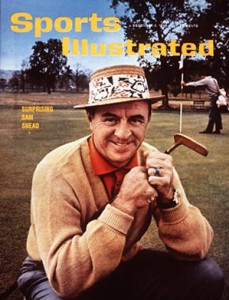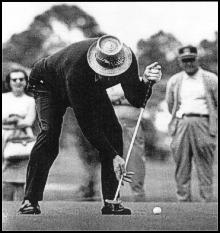by Jeff Skinner
It is only fitting that putters and putting has been the source of so much debate lately. After all, no other club is used as often during a round of golf as the putter and the flat stick, long or short has been the cause of controversy for hundreds of years. At the first U.S. Amateur in 1895 at Newport Country Club a player showed up with a pool cue as a putter. Later, the USGA ruled it illegal because it did not conform to the club equipment standard.
With Keegan Bradley winning the PGA Championship, soon to be Hall of Famer, Phil Mickelson testing one out and more and more young golfers wielding “unconventional” putters the decibel level of the long putter conversation is nearing an ear shattering level.
 As we have seen with the square groove issue the USGA and the R&A only rule after an exhaustive period of data analysis and fact finding. But that wasn’t always the case. When they want to act quickly they can and such was the case in the 60’s when Sam Snead finally found a cure for his yips.
As we have seen with the square groove issue the USGA and the R&A only rule after an exhaustive period of data analysis and fact finding. But that wasn’t always the case. When they want to act quickly they can and such was the case in the 60’s when Sam Snead finally found a cure for his yips.
Slammin’ Sammy still had a good tee to green game in the mid 60’s but his putting touch had left him and he was desperate for a cure. During the 1966 PGA Championship, in the middle of the second round he was so exasperated with his poor putting he tried his novel “croquet” style. He stood facing the hole with his feet astride of his line and swung his putter like a croquet mallet. The improvement was significant and immediate. He finished the PGA tied for sixth place.
That following January at the Senior PGA Championship Snead lapped the field with a nine stroke victory and it looked like Snead had found the elusive cure for the yips. Snead, a three time Masters Champion, took his new croquet style to the 1967 Masters where he had struggled recently with only a T42 as his best finish in a three year span. He tied for tenth that year but at the same time started the forces in motion to ban his unorthodox style.
There were few figures in golf more powerful than Bobby Jones and no one was a bigger traditionalist then Mr. Jones. At The Masters Jones told Snead he didn’t approve of his new putting style. Sam being Sam just putted the way he could to make more putts. The controversy could have died there but Jones wouldn’t let it. He expressed his displeasure to his friend, USGA Executive Director Joseph Dey.
Dey and Snead already had a history of butting heads and Dey was more than willing to carry out Jones’ wish to get rid of Sam’s newfangled putting stance. “The history of the game cries out that you play it from one side of the ball,” Dey said. “Bizarre stances and clubs were beginning to make it look like another game.”
Snead knew that Jones and Dey had got him. “I think they changed the rule because they didn’t like the looks of me putting at the Masters. Some people got talking. They’d say, ‘My God, look at old Sam. He’s playing croquet.’ I think it’s my business how I stroke the ball. It hasn’t been proved that the croquet way is not the best way to putt. I think if I practiced it diligently I’d be a better putter than I ever was before.”
At the time Jack Nicklaus and Gary Player spoke out against the banning of the croquet technique. Player: “I don’t believe you should put a man down to hitting the ball one way.” Nicklaus “This is ridiculous. Why don’t they just let us tee up the ball and play it?” But their cries, as well as Snead’s went unheard.
Shortly after The 1967 Masters the USGA decided to ban Snead’s unique method and the rule went into effect on Jan. 1, 1968. In a matter of months they wrote a new rule and put it in place. Who’s to say they can’t act as quickly now, if they want to.
As the USGA Executive Director said, “Bizarre stances and clubs were beginning to make it look like another game.” That sounds as applicable today as it did when good old Sammy was just trying to sink a few more putts.
Pat Ryan’s story, Sports Illustrated June 5, 1967
Bill Field’s story, Golf Digest April 14, 2011
